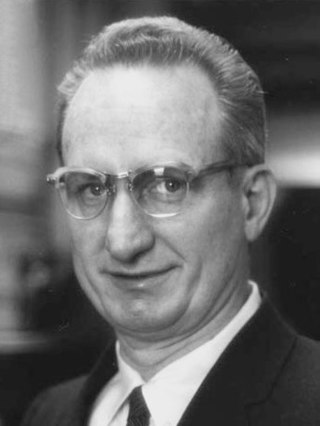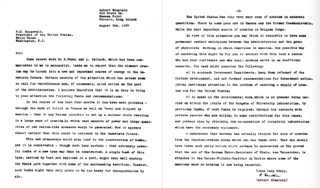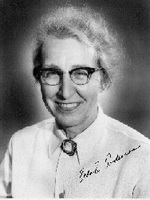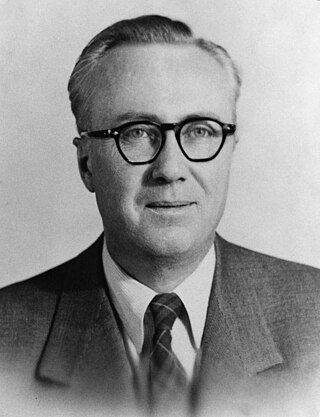Related Research Articles

Enrico Fermi was an Italian and later naturalized American physicist, renowned for being the creator of the world's first nuclear reactor, the Chicago Pile-1, and a member of the Manhattan Project. He has been called the "architect of the nuclear age" and the "architect of the atomic bomb". He was one of very few physicists to excel in both theoretical physics and experimental physics. Fermi was awarded the 1938 Nobel Prize in Physics for his work on induced radioactivity by neutron bombardment and for the discovery of transuranium elements. With his colleagues, Fermi filed several patents related to the use of nuclear power, all of which were taken over by the US government. He made significant contributions to the development of statistical mechanics, quantum theory, and nuclear and particle physics.

A nuclear weapon is an explosive device that derives its destructive force from nuclear reactions, either fission or a combination of fission and fusion reactions, producing a nuclear explosion. Both bomb types release large quantities of energy from relatively small amounts of matter.
Nuclear engineering is the engineering discipline concerned with the design and application of systems that make use of the energy released by nuclear processes. The most prominent application of nuclear engineering is the generation of electricity. Worldwide, some 440 nuclear reactors in 32 countries generate 10 percent of the world's energy through nuclear fission. In the future, it is expected that nuclear fusion will add another nuclear means of generating energy. Both reactions make use of the nuclear binding energy released when atomic nucleons are either separated (fission) or brought together (fusion). The energy available is given by the binding energy curve, and the amount generated is much greater than that generated through chemical reactions. Fission of 1 gram of uranium yields as much energy as burning 3 tons of coal or 600 gallons of fuel oil, without adding carbon dioxide to the atmosphere.

Nuclear fallout is the residual radioactive material propelled into the upper atmosphere following a nuclear blast, so called because it "falls out" of the sky after the explosion and the shock wave has passed. It commonly refers to the radioactive dust and ash created when a nuclear weapon explodes. The amount and spread of fallout is a product of the size of the weapon and the altitude at which it is detonated. Fallout may get entrained with the products of a pyrocumulus cloud and fall as black rain. This radioactive dust, usually consisting of fission products mixed with bystanding atoms that are neutron-activated by exposure, is a form of radioactive contamination.

The Atomic Age, also known as the Atomic Era, is the period of history following the detonation of the first nuclear weapon, The Gadget at the Trinity test in New Mexico, on 16 July 1945, during World War II. Although nuclear chain reactions had been hypothesized in 1933 and the first artificial self-sustaining nuclear chain reaction had taken place in December 1942, the Trinity test and the ensuing bombings of Hiroshima and Nagasaki that ended World War II represented the first large-scale use of nuclear technology and ushered in profound changes in sociopolitical thinking and the course of technological development.

Leo James Rainwater was an American physicist who shared the Nobel Prize in Physics in 1975 for his part in determining the asymmetrical shapes of certain atomic nuclei.

Otto Robert Frisch was an Austrian-born British physicist who worked on nuclear physics. With Otto Stern and Immanuel Estermann he first measured the magnetic moment of the proton. With Lise Meitner he advanced the first theoretical explanation of nuclear fission and first experimentally detected the fission by-products. Later, with his collaborator Rudolf Peierls he designed the first theoretical mechanism for the detonation of an atomic bomb in 1940.

The Soviet atomic bomb project was the classified research and development program that was authorized by Joseph Stalin in the Soviet Union to develop nuclear weapons during and after World War II.

Ugo Fano was an Italian American physicist, notable for contributions to theoretical physics.

A thermonuclear weapon, fusion weapon or hydrogen bomb is a second-generation nuclear weapon design. Its greater sophistication affords it vastly greater destructive power than first-generation nuclear bombs, a more compact size, a lower mass, or a combination of these benefits. Characteristics of nuclear fusion reactions make possible the use of non-fissile depleted uranium as the weapon's main fuel, thus allowing more efficient use of scarce fissile material such as uranium-235 or plutonium-239. The first full-scale thermonuclear test was carried out by the United States in 1952; the concept has since been employed by most of the world's nuclear powers in the design of their weapons.

The Einstein–Szilard letter was a letter written by Leo Szilard and signed by Albert Einstein on August 2, 1939, that was sent to President of the United States Franklin D. Roosevelt. Written by Szilard in consultation with fellow Hungarian physicists Edward Teller and Eugene Wigner, the letter warned that Germany might develop atomic bombs and suggested that the United States should start its own nuclear program. It prompted action by Roosevelt, which eventually resulted in the Manhattan Project, the development of the first atomic bombs, and the use of these bombs on the cities of Hiroshima and Nagasaki.

Strontium-90 is a radioactive isotope of strontium produced by nuclear fission, with a half-life of 28.8 years. It undergoes β− decay into yttrium-90, with a decay energy of 0.546 MeV. Strontium-90 has applications in medicine and industry and is an isotope of concern in fallout from nuclear weapons, nuclear weapons testing, and nuclear accidents.

Elda Emma Anderson was an American physicist and health researcher. During World War II, she worked on the Manhattan Project at Princeton University and the Los Alamos National Laboratory, where she prepared the first sample of pure uranium-235 at the laboratory. A graduate of the University of Wisconsin, she became professor of physics at Milwaukee-Downer College in 1929. After the war, she became interested in health physics. She worked in the Health Physics Division of the Oak Ridge National Laboratory, and established the professional certification agency known as the American Board of Health Physics.

Katharine "Kay" Way was an American physicist best known for her work on the Nuclear Data Project. During World War II, she worked for the Manhattan Project at the Metallurgical Laboratory in Chicago. She became an adjunct professor at Duke University in 1968.

William Clyde Martin Jr. was an American physicist. After receiving his Ph.D. degree from Princeton University in 1956, he joined the staff of the National Bureau of Standards, where he was employed until his retirement in 1998. As Chief of the NBS Atomic Spectroscopy Section from 1962 to 1998, he led the development of its reference data resources on the spectra of rare-earth elements, substantially increased its coverage of highly excited and ionized species, and pioneered the publication of NIST Standard Reference Data on the internet.

The idea that matter consists of smaller particles and that there exists a limited number of sorts of primary, smallest particles in nature has existed in natural philosophy at least since the 6th century BC. Such ideas gained physical credibility beginning in the 19th century, but the concept of "elementary particle" underwent some changes in its meaning: notably, modern physics no longer deems elementary particles indestructible. Even elementary particles can decay or collide destructively; they can cease to exist and create (other) particles in result.
Eileen Gail de Planque was an American nuclear physicist. An expert on environmental radiation measurements, she was the first woman and first health physicist to become a Commissioner at the US government's Nuclear Regulatory Commission (NRC). Her technical areas of expertise included environmental radiation, nuclear facilities monitoring, personnel dosimetry, radiation shielding, radiation transport, and solid state dosimetry.

Leonidas D. Marinelli was the American radiological physicist who is best known for founding the field of Human Radiobiology and developing the Marinelli Beaker.

Valangiman Subramanian Ramamurthy is an Indian nuclear physicist with a broad range of contributions from basic research to Science and Engineering administration.Prof.Ramamurthy started his career in Bhabha Atomic Research Centre, Mumbai in the year 1963. He made important research contributions in the area of nuclear fission, medium energy heavy ion reactions, statistical and thermodynamic properties of nuclei and low energy accelerator applications. During the period 1995-2006, Prof.Ramamurthy was fully involved in Science administration as Secretary to Government of India, Department of Science and Technology, (DST), New Delhi.Other important assignments held by him include Director, Institute of Physics, Bhubaneswar, (1989-1995), DAE Homi Bhabha Chair in the Inter-University Accelerator Centre, New Delhi (2006-2010), and Director of the National Institute of Advanced Studies, Bengaluru (2009-2014). He is a former chairman of the Recruitment and Assessment Board of the Council of Scientific and Industrial Research and has served as a member of the design team of the first Indian nuclear experiment in Pokhran on 18 May 1974. The Government of India awarded him the third highest Indian civilian honour of Padma Bhushan in 2005.
Shyam Sunder Kapoor is an Indian nuclear physicist and a former director of Bhabha Atomic Research Centre. Known for his research on fission and heavy-ion physics, Kapoor is an elected fellow of all the three major Indian science academies – Indian Academy of Sciences, Indian National Science Academy and National Academy of Sciences, India – as well as the Institute of Physics. The Council of Scientific and Industrial Research, the apex agency of the Government of India for scientific research, awarded him the Shanti Swarup Bhatnagar Prize for Science and Technology, one of the highest Indian science awards, for his contributions to Physical Sciences in 1983.
References
- ↑ "In Black and White: A Guide to Magazine Articles, Newspaper Articles, and Books Concerning Black Individuals and Groups", Third Edition, edited by Mary Mace Spradling, 1980, Gale Research, Detroit
- ↑ Blacks in Science and Medicine, by Vivian Ovelton Sammons, 1990, Hemisphere Publishing, New York
- 1 2 3 "Hurray for Waycross, Ga", Pittsburgh Courier, January 9, 1954
- ↑ Abstract 40.441, Reviews of Modern Physics, 1968
- ↑ Biennial Report of the National Bureau of Standards, 1953-1954
- ↑ Annual Report of the National Bureau of Standards, 1957